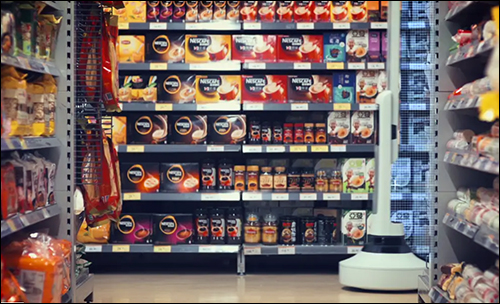Simbe Robotics Brings RFID to Computer Vision Robot
By Claire Swedberg
Tags: Apparel, Inventory / War ehouse Management, Retail
Jul 23, 2018—
California technology company Simbe Robotics has released an RFID-enabled version of its Tally robot. This, according to the company, makes Tally one of the few robots on the market that leverages both computer vision and RFID-based data, as well as having built-in machine-learning capability.
That combination of technology, Simbe Robotics reports, enables companies—such as retailers of electronics, sporting goods or apparel—to access highly accurate inventory counts, along with images of the displays in their stores. With machine learning, the robot can predict where tags are located, the kinds of products to which they are attached and how many there will be, based on their in-store locations. Three companies are currently using the RFID functionality in the robot, says Brad Bogolea, Simbe's founder and CEO, who adds that the system has been commercially released this month.

There are instances, however, when RFID provides mores specific data than computer vision can. Clothing and other goods may be difficult to visually identify and thus pose a challenge for computer vision. A blouse or a pair of pants on a hanger can come in a variety of sizes and styles that the system cannot discern.
As the use of RFID has been growing in the retail market, especially among such high-value goods as sportswear, garments and electronics, Simbe has begun building UHF RFIDfunctionality into its Tally system. Although there are RFID robots already in use in the retail market, Bogolea says, Tally is different in several ways.
For one thing, Bogolea explains, the company designed the latest version of Tally to employ both computer vision and RFID, so that users can use either or both technologies. For instance, many goods still do not have RFID tags attached to them, so a store could employ the computer-vision functionality for those products, while utilizing RFID for items that have EPC UHF RFID tags attached.
Additionally, RFID reads can be accompanied by computer-vision images so that a store manager or corporate retail employee could compare inventory with the appearance of store displays. In that way, they could view the specific displays, compare the data against sales, and determine where goods are selling quickly or slowly, as well as which displays are the most popular.
Tally is a slim robot designed for use in a store front among shoppers and store personnel. It stands on a circular base about 62 inches tall and approximately 18 inches wide, says Durgesh Tiwari, Simbe's hardware research and development VP. The robot's form factor has not changed with the inclusion of RFID, he adds. The company has built a reader leveraging Impinj technology into Tally, as well as an array of antennas that can adjust orientation based on the direction of tag reads.
Tally is slimmer than most RFID-reading robots, Tiwari says, which makes it friendly for store-front use, in which it needs to be non-disruptive. "Some of the stores we've worked with have very narrow aisles," he states, "as well as hanging clothing that hangs in to the aisle." For that reason, the slim size makes it suitable for store-front reading. It comes with a rechargeable battery with a 9- to 12-hour life span and is designed to move through store aisles throughout the day and evening.
Users first create a map for the robot's movement within the store front and back rooms. Tally's built-in sensors enable it to understand where the robot is located on that map at any given time. The system employs the sensordata to understand when there is an obstacle (such as a person) and to negotiate around it, while also finding its way back onto its mapped route.
Typically, Tally moves down aisles at about human walking speed, depending on how densely tags are packed on shelves, reading tags at a rate of up to 700 per second. It travels past one side of the aisle, then typically passes back on the other side to capture products on all shelves. It can read tags from floor level to 5 meters (16.4 feet) high and has built-in intelligence to identify signal strength and the locations of tags based on that strength. In that way, Tally can prevent stray reads from products in neighboring aisles.
Tally's RFID functionality allows it to capture inventory data at 99 percent accuracy or greater, the company reports, so that stores have fast inventory updates regarding stock levels in store fronts and back rooms. The system not only enables stores to replenish when stock levels are low, but also can be used to help locate an item when a customer requests it. For instance, if someone orders items online, with plans to pick them up at the physical store, personnel can access the Simbe inventory data to view where each product was last located by Tally, and then proceed to that location.
The technology also reduces the need for handheld RFID inventory counts, which can be time-consuming and depend on participation by a sales associate who might otherwise be helping customers. "The core value of Tally is to free up the sales associate to focus on customer service," Bogolea states. While the system requires less manual effort by store employees, it is also less expensive than a fixed readerinfrastructure that would otherwise be required for those wishing to access RFID inventory data without requiring the sales staff to use handheld readers.
So far, Bogolea says, "All our deployments have been able to perform inventory counts at par or greater [accuracy] than handheld read scans." He adds that the system has been put to the challenge with high shelves and metal fixtures that could reflect RF signals. "We've been pleasantly surprised at the performance we're getting in stores," Bogolea states.
In the future, Tiwani reports, the company may opt to provide the Tally solution for customers beyond the retail market. "We've seen a lot of requests from potential customers who are not in retail," he says, though he declines to provide specifics at this juncture.
News link:http://www.rfidjournal.com/articles/view?17701/3


















